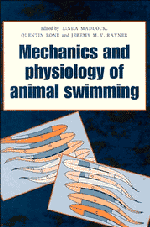Book contents
- Frontmatter
- Contents
- Contributors
- Introduction
- 1 Functional patterns of swimming bacteria
- 2 Buoyancy and swimming in marine planktonic protists
- 3 The role of fins in the competition between squid and fish
- 4 The biology of fish swimming
- 5 Swimming physiology of pelagic fishes
- 6 The mechanical design of the fish muscular system
- 7 How do fish use their myotomal muscle to swim? In vitro simulations of in vivo activity patterns
- 8 The timing of lateral muscle strain and EMG activity in different species of steadily swimming fish
- 9 Swimming in the lamprey: modelling the neural pattern generation, the body dynamics and the fluid mechanics
- 10 Swimming capabilities of Mesozoic marine reptiles: a review
- 11 Stone, bone or blubber? Buoyancy control strategies in aquatic tetrapods
- 12 Functional anatomy of the ‘flight’ apparatus in penguins
- 13 Energy conservation by formation swimming: metabolic evidence from ducklings
- Bibliography
- Index
4 - The biology of fish swimming
Published online by Cambridge University Press: 05 March 2012
- Frontmatter
- Contents
- Contributors
- Introduction
- 1 Functional patterns of swimming bacteria
- 2 Buoyancy and swimming in marine planktonic protists
- 3 The role of fins in the competition between squid and fish
- 4 The biology of fish swimming
- 5 Swimming physiology of pelagic fishes
- 6 The mechanical design of the fish muscular system
- 7 How do fish use their myotomal muscle to swim? In vitro simulations of in vivo activity patterns
- 8 The timing of lateral muscle strain and EMG activity in different species of steadily swimming fish
- 9 Swimming in the lamprey: modelling the neural pattern generation, the body dynamics and the fluid mechanics
- 10 Swimming capabilities of Mesozoic marine reptiles: a review
- 11 Stone, bone or blubber? Buoyancy control strategies in aquatic tetrapods
- 12 Functional anatomy of the ‘flight’ apparatus in penguins
- 13 Energy conservation by formation swimming: metabolic evidence from ducklings
- Bibliography
- Index
Summary
This chapter explores the ways fish swim from zero speeds in station-holding and hovering, through cruising and sprint, to fast starts. The range of power required to swim over such a range is formidable. Effective swimming is achieved by performance range fractionation using gaits. Gaits are defined by the use of various combinations of propulsor type (median and paired fin or body/caudal fin propulsors), propulsor kinematics (station-holding, hovering, steady swimming and fast starts, muscle (red, pink and white), and locomotor behaviour (continuous and burst-and-coast swimming). The number of gaits expressed within lineages, and presumably locomotor performance range, has generally increased over evolutionary time. At any given evolutionary level, radiations have been common, often enhancing certain gaits but reducing performance in others (gait suppression). The range of gaits expressed during ontogeny also increases. Environmental influences tend to reduce metabolic scope so that successive gaits tend to be recruited at lower speeds (gait compression). Directions for future research include use of computational models better to model pressure distributions and forces during swimming. Problems especially of manoeuvrability, agility and stability have been neglected by traditional interest in maximum speed and acceleration.
INTRODUCTION
Fish are famed for their swimming prowess. But many species also walk over the aquatic and terrestrial substratum (Grobecker & Pietsch, 1979; Gans et al., 1994) and others glide through the air (Fish, 1990). Fish swimming immediately suggests flashing fins, but some move by jet propulsion (Fish, 1987). Thus fish employ all axial and appendicular propulsor organs, their attendant muscles, and several behaviours in a wide variety of locomotor modes (Webb & Blake, 1985; Webb, 1993, 1994a).
- Type
- Chapter
- Information
- The Mechanics and Physiology of Animal Swimming , pp. 45 - 62Publisher: Cambridge University PressPrint publication year: 1994
- 138
- Cited by



